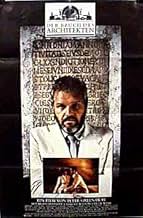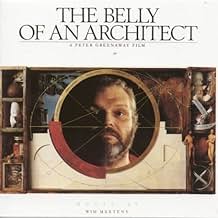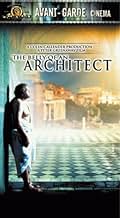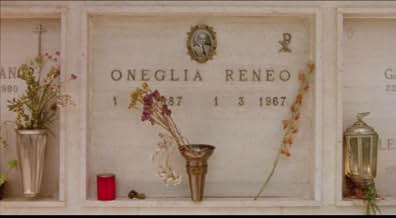Un arquitecto que supervisa una exposición comienza a tener misteriosos dolores de estómago mientras su vida se desmorona lentamente.Un arquitecto que supervisa una exposición comienza a tener misteriosos dolores de estómago mientras su vida se desmorona lentamente.Un arquitecto que supervisa una exposición comienza a tener misteriosos dolores de estómago mientras su vida se desmorona lentamente.
- Premios
- 2 nominaciones en total
- Trettorio
- (as Marino Mase)
- Dirección
- Guionista
- Todo el elenco y el equipo
- Producción, taquilla y más en IMDbPro
Opiniones destacadas
The film follows the parallels of these two unappreciated architects from different eras. The film is memorable for Dennehy's (an actor who is also unappreciated) remarkable performance. Also, the beautiful cinematography by Greenaway's trusty DOP Sacha Vierny makes the film very easy to look at. From the ancient architecture of Rome, to a painting-like bowl of figs, it is pristine-looking. Michael Nyman is absent, but the music by Wim Mertens is splendid. This film was made in between A Zed & Two Noughts and Drowning by Numbers, and it is quite unlike those two films, which, I think, are superior to this in the way they offer us a much more enigmatic, abstract concept. But even an ever so slightly lesser Greenaway film is a thing to behold.
The idea is especially powerful in the context of architecture, that we use form to project outwards a set of ideals but, having understood ourselves eventually circumscribed by structures that describe us, we can then use them to describe the inner landscape.
So indeed, we stroll around one such interior Rome, where earlier decadence or glory, or masks thereof, greeting us from marble balustrades and rows of pillars reflect inside. A city so ornately decorated and cast in stone, as though man would outlast his follies.
Into this comes an American architect - the man whose folly is to build things that last - to stage an exhibition for some obscure French architect who died 180 years ago. Italians are not too happy that he hasn't picked one of their own, but they oblige to finance nonetheless.
There are two broad ideas that Greenaway is careful to lightly caress, tease out their potential implications, but finally circumnavigate. The film would have been lesser had it settled on either, or is perhaps greater for encompassing both.
One is the doubling; the architect begins to imagine himself as his older counterpart, writing letters to him in the form of private confessional; then begins imagining himself as emperor Augustus, trapped in the same ploy of marital infidelity and murder. He replicates these stories around him. So these people overlap and are mirrored with bellies, bellies aching with the toll of creation. At this point you may think it is all going to be another film about the creative person losing himself in the mind, merging life with narrative.
The other is, as always with Greenaway, about all this as doubling for the making of the film. It's a film-within device, make no mistake. So the visionary artist is increasingly frustrated by lackeys, ignorant money-men, virulent antagonists scheming to usurp him; energy is wasted in duplicitous dinner parties and idle, but always more or less venomous, chit-chat, until eventually finds himself embittered and alone in his own set.
But it is not merely about the price of genius, or a satire of the contemporary civilized arena that it has to bleed into.
Look for the scene with his doctor in front of the busts of emperors; each bust a face and story, one decadent and evil, another perhaps famed as wise, but all inadvertently gone. A little further down is a bust without name, it could be anyone's, and whatever story will be inscribed upon it, it's again only destined to join this gallery of fiction. It is important to see these follies, but more important to see the continuity.
So it is this acceptance on the part of the architect, the man who builds things not only to last but to be beautiful in time, of the turn of the wheel, decline through rebirth. It is powerful stuff to see; the scene in the police station near the end, where he is simply asked name and age, whether married or not. He is free to go then. He has been jotted down in the ledgers.
The final scenes in the exhibition center echo with this casual dismissal of a life lived, a casual but sweet, relieving it would seem, departure after so much grief with nothing to weigh on the shoulders. He attends the exhibition, the work of a lifetime, from the balustrade above, from the vantage point of not being involved anymore. Everything looks like a small ceremony from there. So this is the nested world that matters; not the exhibition, but the creative life on the ego-redemptive journey through life at large, purging itself of itself, after the painful struggle to master the world building pantheons finally submitting to be the mastered world, transient, as it comes into being and goes again.
As he goes, new life is born down below - and plays, again and again it would seem, before the colossal marble structures.
It is perhaps the ideal Greenaway film; the self-referential tics are all present, the framework ornate, but instead of chaotic it is all mastered into a pillar that supports, unifies vision. The architect - on more levels than one - coming to terms with the architecture of a transient life.
I can only imagine that he thought he could finance his serious work with a commercial success. Some might tag this as an accessible Greenaway film, but I hardly think it is Greenaway at all. Nor is the remarkable composer Nyman present.
All that remains are some lush compositions, studies in photographing monumental architecture, and these are pleasant enough. A subtext is fascist perfidy in architecture and the film takes a critical (visual) stance on Roman architecture. See here how all the buildings are from the emperors or Mussolini. No church architecture here which must have been a conscious omission for simplicity.
Everything about the physical fabric portrayed is dehumanizing, especially as compared to the containing space of the skin. As an architect myself, I can appreciate the message. It is a clever conceit, but it pales, utterly fades away, in comparison to his best: `The Falls,' and the `book' films.
Peter Greenaway directs High Art films that flirt with the limits of watchability -- I've never been able to get past the initial image in PROSPERO'S BOOK, of John Gielgud in hs bath, watered by cherubs like a garden fountain. This one is very watchable, with its bits of color, and Dennehy's solid performance against the wreckage of classical art through the movie's Rome; there's one funny moment when he uses the feet of a colossal sculpture to scratch his back. Yet, in the end, Dennehy's performance takes over the entire movie, leaving everyone else as bit players. Others' motives, except for Lambert's greed, remain obscure. Is Greenaway satirizing the excessive intellectualization of a practical art of which he himself is guilty?
¿Sabías que…?
- TriviaBrian Dennehy was quoted after the release as saying "I've made lots of movies but only one film."
- ErroresWhen photocopying the picture of Augustus, Kracklite puts the picture in upside down which would have given a blank copy (unless the same picture was on both sides). Additionally, it would not be possible to achieve the level of resolution of Augustus' abdomen from such a small picture.
- Citas
Caspasian Speckler: Your wife is very beautiful, Signor Kracklite, especially when she is pregnant.
Stourley Kracklite: Yes, that's right. She is pregnant. But not with your child, Speckler.
Caspasian Speckler: True. I'm very grateful to you for that. Your child, shall we say, is the most perfect contraceptive.
[Kracklite turns and punches Speckler in the nose]
- ConexionesFeatured in Peter Greenaway (1992)
Selecciones populares
- How long is The Belly of an Architect?Con tecnología de Alexa
Detalles
- Fecha de lanzamiento
- Países de origen
- Idiomas
- También se conoce como
- The Belly of an Architect
- Locaciones de filmación
- Productoras
- Ver más créditos de la compañía en IMDbPro
Taquilla
- Total en EE. UU. y Canadá
- USD 287,725
- Tiempo de ejecución1 hora 59 minutos
- Color
- Mezcla de sonido
- Relación de aspecto
- 1.85 : 1
Contribuir a esta página
































